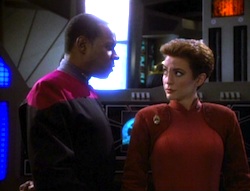Star Trek: Deep Space Nine First Season
Original air dates: January – June 1993
Executive Producers: Rick Berman & Michael Piller
Station log: For the first time, there was a Star Trek show that couldn’t be described with those fateful words, “These are the voyages of the starship Enterprise.” With the debut of “Emissary” in January 1993, the definition of Star Trek changed forever.
There were a lot of firsts here in the opening season of DS9, beyond the obvious fact that this was the first Trek TV show not set on a ship named Enterprise, indeed the first to take place in a (somewhat) static location. It was also the first Trek show with a black commanding officer and a female first officer, and the only Trek show to date with a person of Arab descent in the main cast (which is actually more noteworthy now than it was twenty years ago, more’s the pity). It’s also the only Trek show to have more than two people in the opening credits who aren’t with Starfleet (TNG had Wesley, at least until “Where No One Has Gone Before,” Voyager had only Neelix and either Kes or Seven of Nine, and Enterprise had only T’Pol, at least until the fourth season, and Phlox)—indeed, only half those listed in the opening credits are with Starfleet.
It’s also the first Trek show to be aggressively serialized—a natural by-product of their staying in one place—with many of the show’s recurring elements begun in this first season: Bajor crawling from the wreckage of the Cardassian occupation (“Emissary,” “Past Prologue,” “The Storyteller,” “Progress,” “Duet,” “In the Hands of the Prophets”), encountering stuff in and/or from the Gamma Quadrant (“Captive Pursuit,” “Q-Less,” “Move Along Home,” “Vortex,” “Battle Lines,” “If Wishes Were Horses,” “Dramatis Personae”), Ferengi politics (“The Nagus”), Trill politics (“Dax”), Cardassian politics (“Duet”), and the developing relationships among the various characters (Kira and Sisko in “Past Prologue,” “Progress,” “Duet,” and “In the Hands of the Prophets”; O’Brien and Bashir in “The Storyteller”; Jake and Nog in “A Man Alone,” “The Nagus,” “The Storyteller,” and “Progress”; Odo and Kira in “Past Prologue,” “A Man Alone,” and “Duet”; Odo and Quark in pretty much every episode; the two Siskos in every episode that includes Jake).
Highest-rated episode: “Duet,” the season’s only 10, with honorable mention to the season’s only 9, “Progress.”

Lowest-rated episode: A tie between “A Man Alone” and “The Passenger,” both achieving only a 2.
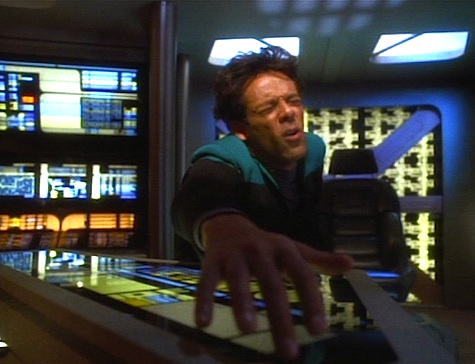
Most comments (as of this writing): “Emissary” with 101, only the second time we’ve cleared 100 comments (the other being TNG’s“Darmok”).
Fewest comments (as of this writing): “The Forsaken” with only 27, the only one to be under 30. What, no love for Lwaxana?
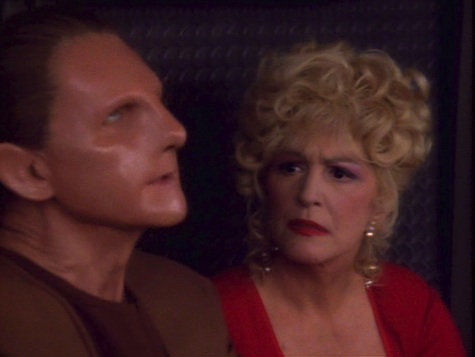
Favorite Can’t we just reverse the polarity?: From “If Wishes Were Horses”: “Perimeter sensors are picking up a subspace oscillation. What the hell does that mean?”
Kira speaking for us all.
Favorite The Sisko is of Bajor: From “Q-Less”: Sisko decks Q.
Nothing really to add there, it’s just so sufficiently spectacular that it’s worth repeating.
Sisko decks Q.
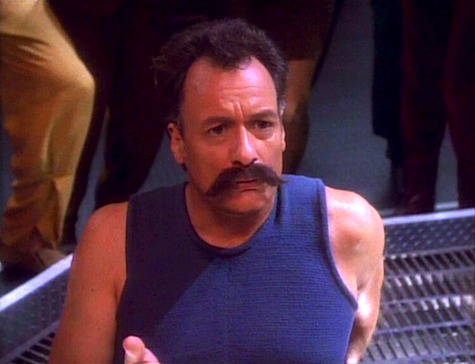
Favorite Don’t Ask My Opinion Next Time: From “Babel”: Kira shows some investigative chops—tracking Surmak through his signing of Dekon’s death certificate—and her underground training in doing whatever you need to do to get the job done via her basically kidnapping Surmak from his office. (She makes sure he’s alone in his office before beaming him out, and it’s an open question whether or not she’s doing it to avoid anyone else being transported or to avoid there being any witnesses.)
Kira also assumes that the device is Cardassian, but when further investigation reveals that it’s Bajoran, she’s completely unapologetic about the conclusion to which she originally jumped.
Favorite Rule of Acquisition: From “Q-Less”: Quark and Vash were made for each other. He sets up her auction, picking some select clientele—selected, as he explains to Odo, by virtue of their being incredibly wealthy and not too bright.
He also says “bid high and bid often,” a delightfully Ferengi play on the quote attributed to Chicago Mayor Richard Daley, “vote early and vote often.”
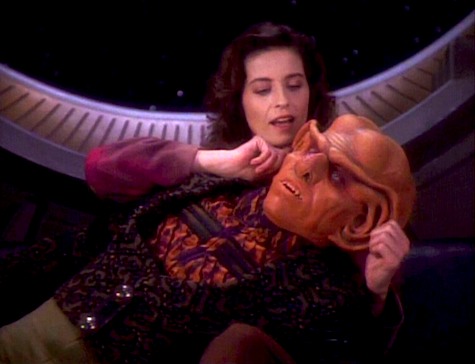
Favorite Preservation of mass and energy is for wimps: From “The Forsaken”: For the first time, we see Odo losing cohesion and being forced into his liquid form to regenerate, with Lwaxana catching him in the folds of her dress, a special effect that is utterly unconvincing either visually or scientifically. (Seriously, how did she keep it all in there? How was she able to support his weight?)
Favorite The slug in your belly: From “The Forsaken”: When Sisko was Curzon Dax’s adjutant, he used to delight in giving Sisko crap assignments very much like the one Sisko gives Bashir. When Bashir exasperatedly asks how he “graduated” from this duty, Sisko replies that it was when he hauled off and belted a VIP who was trying to get an unwilling ensign to go back to his quarters. Bashir gets a faraway look in his eyes, no doubt imagining that circumstance transplanted to his own situation, but Sisko puts the kibosh on it, as he’s less understanding than Curzon. Bashir is very obviously disappointed at having the hauling-off-and-belting option being taken off the table.
In addition, Lojal tries to insert himself into Dax’s scientific inquiry into the probe, thinking her too young and inexperienced. Bashir stops him, pointing out that she has three centuries’ experience.
Favorite For Cardassia! From “Emissary”: Dukat wastes no time in returning to his old stomping grounds to remind Sisko that he’s nearby and that his intelligence sources on Bajor are still quite good, mentioning that he knows that Sisko visited Opaka and brought an orb back. It’s clear that withdrawing from Bajor was not his idea and occurred over his objection.
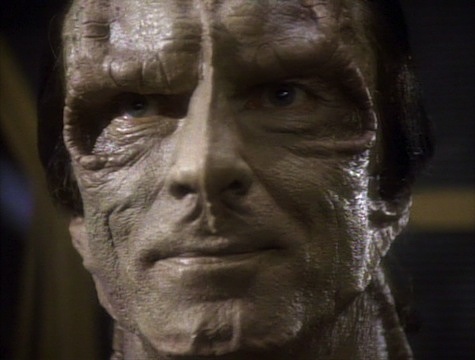
Favorite Plain, simple: From “Past Prologue”: We get our first look at the mysterious tailor who will become such a major part of the show. He befriends Bashir for reasons that likely range from the entertainment value of watching him thumpher about nervously in response to Garak’s possible double meanings to genuine use for him as a method of communicating covertly with Sisko (something Sisko himself figures out in short order). At this stage, it’s unclear what Garak is doing on the station beyond selling clothing. He’s willing to let Lursa and B’Etor believe that he still has pull on Cardassia, though we never see him actually contact home. Indeed, the only person he seems to get in touch with is Bashir, leading one to think that he promised the Klingon women payment he couldn’t come through with. (Of course, the Cardassians never got Tahna, so the Klingons wouldn’t be entitled to payment, exactly…) Either way, right off the bat we get Garak’s trademark charm, layered conversation, euphemisms, and torturing of Bashir, all continued hallmarks of the character.
Favorite What happens in the holosuite, stays in the holosuite: From “If Wishes Were Horses”: With all the humans coming to the station, Quark is considering opening up more holosuites that have family entertainment, in addition to the more sordid ones. This prompts Odo to call Quark disgusting, to which Quark replies happily, “Till the day I die.”
Favorite No sex, please, we’re Starfleet: From “A Man Alone”: Bashir continues to hit all over Dax, while Quark admires her from afar as well. Sisko also makes it clear that he has no sexual interest in Dax and the way is clear for Bashir to take his shot. Dax herself deflects Bashir by saying that Trill try to rise above such notions. This has the smell of bullshit being shoveled solely to deflect Bashir’s tiresome pursits, and that smell gets stronger when Sisko starts reminiscing about him and Curzon and the twins….
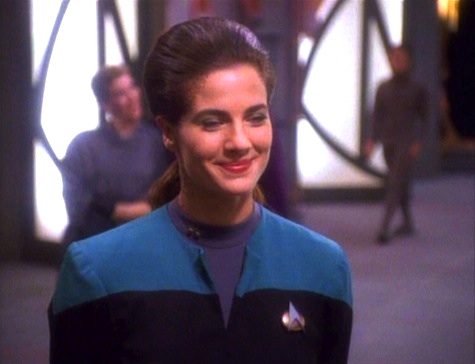
Favorite Welcome aboard: Lots of interesting guests this season, starting with the recurring characters who all make their debut: Marc Alaimo as Dukat (“Emissary,” “Duet”), Philip Anglim as Bareil (“In the Hands of the Prophets”), Felicia Bell as Jennifer (“Emissary”), Aron Eisenberg as Nog (“Emissary,” “A Man Alone,” “The Nagus,” “The Storyteller,” “Progress”), Louise Fletcher as Winn (“In the Hands of the Prophets”), Anne Gillespie as Jabara (“Babel”), Max Grodenchik as Rom (“Emissary,” “A Man Alone,” “The Nagus,” “Vortex”), Andrew J. Robinson as Garak (“Past Prologue”), Camille Saviola as Opaka (“Emissary,” “Battle Lines”), Wallace Shawn as Zek, and Tiny Ron as Maihar’du (both in “The Nagus”).
Then we have the Next Generation folks who came on over to the spinoff for a spell: Majel Barrett as Lwaxana (“The Forsaken”), Rosalind Chao as Keiko (“A Man Alone,” “If Wishes Were Horses,” “In the Hands of the Prophets”), John deLancie as Q (“Q-Less”), Hana Hatae as Molly (“A Man Alone,” “If Wishes Were Horses”), Jennifer Hetrick as Vash (“Q-Less”), Barbara March as Lursa (“Past Prologue”), Sir Patrick Stewart as Picard/Locutus (“Emissary”), and Gwynyth Walsh as B’Etor (“Past Prologue”).
Some excellent character actors did fine work this season as well: Michael John Anderson as Rumpelstiltskin (“If Wishes Were Horses”), Vaughn Armstrong as Danar (“Past Prologue”), Jonathan Banks as Shel-la (“Battle Lines”), Joel Brooks as Falow (“Move Along Home”), Cliff DeYoung as Croden (“Vortex”), Fionnula Flanagan as Enina (“Dax”), Gerritt Graham as the hunter (“Captive Pursuit”), Anne Haney as the magistrate (“Dax”), Gregory Itzin as Tandro (“Dax”), Scott MacDonald as Tosk (“Captive Pursuit”), Jeffrey Nordling as Tahna (“Past Prologue”), Randy Oglesby as Ah-Kel/Ro-Kel (“Vortex”), and Keone Young as Bokai (“If Wishes Were Horses”).
But nothing will beat two magnificent guest turns by two grand old men of the acting profession: Brian Keith as the irascible Mullibok in “Progress” and Harris Yulin as the troubled Marritza in “Duet.”
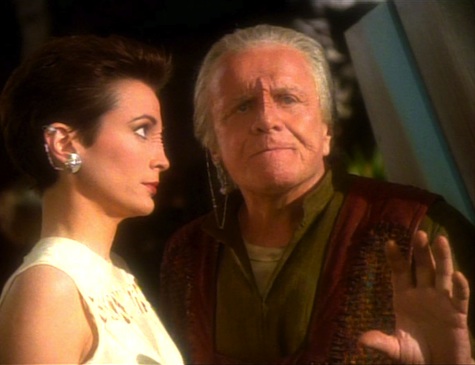
Favorite Keep your ears open: From “Emissary”: “This’ll be perfect! Real frontier medicine!”
“Frontier medicine?”
“Major, I had my choice of any job in the fleet.”
“Did you?”
“I didn’t want some cushy job or research grant. I wanted this! The farthest reaches of the galaxy, one of the most remote outposts available.This is where the adventure is, this is where heroes are made—right here, in the wilderness.”
“This ‘wilderness’ is my home.”
“I—I didn’t mean—”
“The Cardassians left behind a lot of injured people, Doctor. You can make yourself useful by bringing some of your Federation medicine to the natives. Oh, you’ll find them a friendly, simple folk.”
Bashir being an arrogant, pompous ass and Kira taking the piss out of him.
Favorite Trivial matter: Probably the one for “Emissary,” since the show picked up on so many different threads from so many different places, and set up so many more.
Walk with the Prophets: While the first season of DS9 is not its strongest, it’s still a good collection of science fiction stories that set the stage for what the show as a whole will accomplish. This is as strong a group of characters as you’ll find on any television show, and when they get to shine is one of two occasions when the show is at its best: Sisko’s struggles with being a single father (“Emissary,” “The Nagus”), Kira’s adjusting to life after the occupation (“Past Prologue,” “Progress,” “Duet,” “In the Hands of the Prophets”), Odo’s isolation and quest for his identity (“Vortex,” “The Forsaken”), Dax carrying the weight of her past lives (“Dax”), Jake and Nog’s developing friendship (“A Man Alone,” “The Nagus,” “The Storyteller,” “Progress”), and so on.
The other time the show is at its best is when it embraces what makes the show unique: its location near Bajor, recovering from the Cardassian occupation. Most of the season’s best stories deal with that particular aspect of the setting—with some exceptions, as there were strong episodes that didn’t deal with it (“Captive Pursuit”) and weak episodes that did (“The Storyteller”).
As the first spinoff of TNG, with producers understandably unsure of how the audience would respond, any number of TNG elements were included to ease the transition. Besides the obvious—the use of Cardassians and Bajorans, both introduced on TNG, and bringing the O’Brien family over from the Enterprise, as well as having Sir Patrick Stewart on hand in “Emissary” to pass the torch, as it were—there were the episodes “Past Prologue,” “Q-Less,” and “The Forsaken,” all using familiar guest stars from past (and future) TNG episodes.
Even the first season’s biggest problem—too many generic science fiction plots that could too easily have been used on any space opera show—was sometimes ameliorated by the uniquely DS9 elements, like the virus in “Babel” having its origins in Bajor’s resistance against the Cardassians.
Yes, it will be better when episodes that really dig into the characters and setting become more common than the technobabble-of-the-week episodes, but that’ll happen soon enough, and this first season did a fine job of introducing the show.
Warp factor rating for the season: 6
Keith R.A. DeCandido will be at Dexcon 16 this weekend in Morristown, New Jersey. He’ll have a table in the dealers room, so come on by and say hi.
Administrative note: There will be no rewatch on Friday the 5th because of the Independence Day weekend. We’ll be back on Tuesday the 9th with the second-season opener, “Homecoming.”










